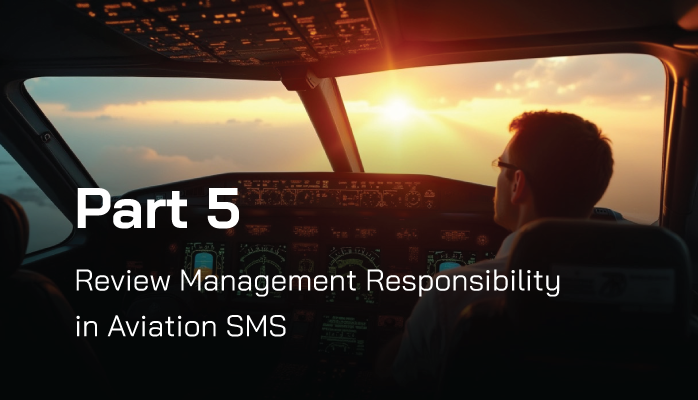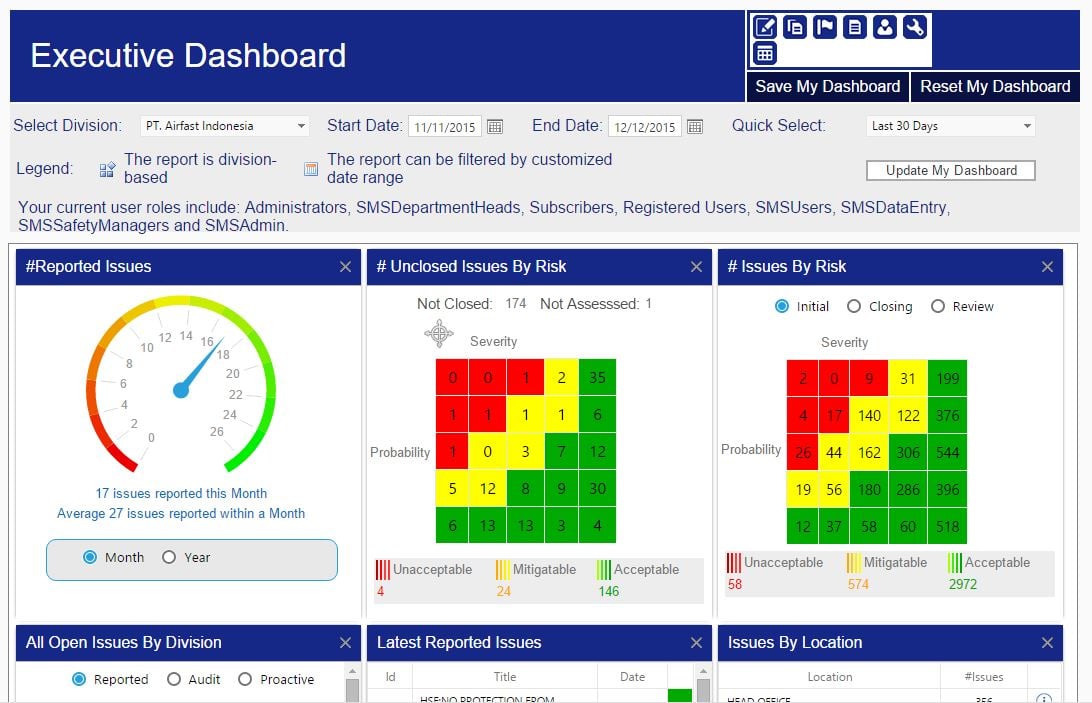Daily SMS Activities May Preclude Routine Review

The new year has started. Business activities are beginning to return to full speed. At full speed, aviation safety managers may be putting out fires. These fires may cause safety teams to look continuously ahead when they should occasionally be looking back.
Aviation safety managers at all stages of their aviation safety management system (SMS) implementations should be monitoring activities relevant to the phase of their SMS implementation.
Regardless of whether your review is many months away or next week, we'll consider two highly important things safety managers should be reviewing regularly.
Related Aviation Safety Manager Task Review Articles
- Best Practices: Reviewing Aviation SMS Manuals
- 5 Tips Reviewing Hazards, Risks & Controls in Aviation SMS - With Examples
- How to Review Your Aviation Safety Risk Management Procedures
Aviation SMS Implementations Are Marathons, Not Sprints
For those safety managers just starting their SMS implementations, it is recommended that you don't try to implement your aviation SMS all at once, for it is impossible to do. Therefore, you should focus on the phased approach, such as described in ICAO's SMS documentation. There are four phases:
- Planning SMS Implementation;
- Reactive Safety Management Processes;
- Proactive and Predictive Safety Management Processes; and
- Operational Safety Assurance.
In most cases, experienced safety managers will have scheduled a review of their implemented aviation SMS. If you have not scheduled a review, we highly recommend that you do this now. SMS implementation reviews will be done at intervals relative to the SMS' maturity level. For example, a newly implemented SMS under two years old will be reviewed quarterly or after major milestones have been completed.
What are considered "major milestones" in the SMS' implementation? Well, this requires just a small bit of common sense to determine. For example, assigning the accountable executive is an incredibly important activity of the SMS implementation, however, there really isn't too much work to do here except ensure the accountable executive is:
- trained in SMS fundamentals (such as an SMS course for executives);
- understands his responsibility to the SMS; and
- in agreement for regular SMS performance monitoring activities with the safety team.
While assigning the accountable executive to the SMS should not trigger a review, here are a few SMS implementation activities that may trigger these unscheduled reviews:
- Completion of the gap analysis;
- Final draft of the SMS implementation plan;
- System description along with preliminary identification of system hazards; and
- After completing the draft of each phase's SMS documentation.
Who will be performing the review? This decision may be different based on the size and complexity of the operation. Generally, the review should include the safety manager and accountable executive at a bare minimum.
Related FAA 14 CFR Part 5 SMS Implementation Articles
- FAA Part 5 Safety Policy: What Do They Mean for Aviation SMS?
- FAA Part 5 - Danger in Safety Accountability & Authority in Aviation SMS
- FAA Part 5 - Understanding Scope of Aviation SMS Implementation
Aviation SMS Activities to Consider Reviewing
Unless a major triggering activity initiates a review, the safety team assigned for SMS implementation will be reviewing the SMS on a fairly regular schedule. You may be reviewing quarterly or semi-annually. Once per year is not frequent enough to identify shortcomings and correct them in a timely manner. After two to three years of successfully participating in Phase 4 of the SMS implementation, you may elect to review the SMS implementation annually to ensure you are not back-sliding. Back-sliding is very common, so don't get caught unawares.
Let's consider which activities to consider regularly reviewing in the SMS implementation. Here, we'll focus on an ICAO-compliant SMS implementation's first phase in which the FAA Part 5 regulations align. Here are two extremely important activities to review to ensure your aviation SMS implementation stays on course:
- Identify accountable executive; and
- Identify safety accountabilities of managers.
Identify Accountable Executive

If you have an aviation SMS, chances are that you already have identified an accountable executive. But...
Has the accountable executive changed?
Does the accountable executive know and understand their responsibilities?
Has he reviewed his responsibilities and has this review been documented?
Are there processes in place for the accountable executive to regularly monitor SMS performance?
Are these SMS performance monitoring activities documented?
Here is a quick review of the accountable executive's responsibilities from FAA's Part 5 Safety Management Systems. This comes from subsection 5.25 Designation and responsibilities of required safety management personnel.
(b) Responsibilities of the accountable executive. The accountable executive must accomplish the following:
(1) Ensure that the SMS is properly implemented and performing in all areas of the certificate holder’s organization.
(2) Develop and sign the safety policy of the certificate holder.
(3) Communicate the safety policy throughout the certificate holder’s organization.
(4) Regularly review the certificate holder’s safety policy to ensure it remains relevant and appropriate to the certificate holder.
(5) Regularly review the safety performance of the certificate holder’s organization and direct actions necessary to address substandard safety performance in accordance with § 5.75.
What we don't see here from FAA's Part 5 is that the account executive is also responsible for providing support for the aviation SMS.
Accountable executives' support must be:
- Visibly obvious to all employees;
- Adequate financially; and
- Sufficiently available for safety personnel.
Visible support may take several forms:
- Messages in safety newsletters;
- Participation in safety committee meetings; and
- Being seen publicly with the safety team, such as on walkabouts.
Financial support may be in the form of
- hiring enough staff to manage the SMS; or
- budget for aviation SMS software tools to manage all the SMS documentation requirements.
Do employees have enough budget for SMS training?
Personnel support would be ensuring that sufficient human resources are tasked with SMS implementation and maintenance of the SMS. Furthermore, are these human resources qualified?
Related FAA 14 CFR Part 5 SMS Implementation Articles
- FAA Part 5 - Monitor Safety Risk Controls in Aviation SMS
- FAA Part 5 Compliance | Safety Risk Management System Description Requirement
- FAA Part 5 Compliance | Safety Risk Management Hazard Identification Requirement
Identify Safety Accountabilities of Managers
One of my pet peeves about aviation SMS implementations over the past dozen years is the current attitudes of managers not participating in the SMS. In the majority of organizations I have worked with, managers in other departments view SMS as the major responsibility of the safety team and the accountable executive. They don't view SMS implementations as a shared responsibility. This attitude is a remnant of the traditional safety program.
We all remember the traditional safety program...you know the one...where management:
- was not expected to participate;
- provided little oversight;
- provided no additional safety budget, or only a very meager, token budget;
- had no expectations of safety being a profit driver; and
- was not held accountable to prescribed "standards" by regulatory agencies.
I'm delighted that attitudes are slowly changing.
Related FAA 14 CFR Part 5 SMS Implementation Articles
- FAA Part 5 Compliance | SRM Risk Analysis Requirement
- Part 5 Compliance | SRM Risk Assessment Element
- FAA Part 5 Compliance | SRM Risk Control Component
An accountable executive told me recently that he wants aviation SMS tools that can be used by all managers to be actively involved in their SMS. This is a Canadian company, so if my calculations are correct, it will be another ten years for other countries to mature to this level. I'll exempt Australia from this blanket statement because I continue to be a firm believer that Australians and Canadians are true leaders in aviation SMS implementations.
Let us continue with subsection 5.25:
(c) Designation of management personnel. The accountable executive must designate sufficient management personnel who, on behalf of the accountable executive, are responsible for the following:
(1) Coordinate implementation, maintenance, and integration of the SMS throughout the certificate holder’s organization.
(2) Facilitate hazard identification and safety risk analysis.
(3) Monitor the effectiveness of safety risk controls.
(4) Ensure safety promotion throughout the certificate holder’s organization as required in subpart E of this part.
(5) Regularly report to the accountable executive on the performance of the SMS and any need for improvement.
The Canadian manager I referred to above knew, it would take more than the safety team to manage all the above elements detailed in subsection 5.25(c).
For example, let's consider; (2) Facilitate hazard identification and safety risk analysis.

Safety professionals typically have operational experience, but no safety manager is a subject matter expert in all operational areas. Therefore, other operational managers must be participating in routine:
- Hazard identification;
- Hazard's safety risk analysis
- Review and assess effectiveness of risk controls; and
- Safety Promotion.
Safety promotion is often left to the safety team; however, it is almost always impossible to create safety promotion content that resonates with all employees because they come from a wide range of departments, such as:
- Flight ops;
- Ground handling/ramp;
- Cabin crew;
- Facilities; and
- Engineering/maintenance.
This is one reason I believe that the best safety newsletter articles are written by functional group managers and not simply authored by the safety team.
Finally, when you review the safety accountabilities of managers, I believe it is best that you document that each manager has reviewed and understands their safety duties and responsibilities. This review exercise can be seen as serving as both:
- SMS training; and
- Safety promotion activity.
Related Aviation SMS Training Articles
- Most Important Safety Training in Aviation Risk Management
- How to Automate Aviation SMS Training in 4 Steps Using Your Safety Program
- Why Initial SMS Training Is So Crucial for Risk Management Programs
Final Thoughts on Reviewing Management Responsibilities
While this discussion used FAA's Part 5 as our reviewing document, these principles apply to all aviation SMS implementations, whether you are at:
- Airlines;
- Airports;
- Maintenance organizations;
- Flight schools;
- Air traffic control; or
- Manufacturing company.
Furthermore, these principles are as valid in Canada or another ICAO member state as they are in the United States.

An aviation SMS implementation is only as good as its tools and the employees using those tools. Good aviation SMS tools should be user-friendly to all user groups,
- from the safety team,
- to operational managers, and
- to all employees.
Furthermore, they should cut your auditing time to 25% of what you normally would expect. SMS performance monitoring and receiving overdue alerts for important safety activities allow management to focus on treating safety items instead of spending too much valuable time in simply managing the paperwork.
Do your aviation SMS software tools save you sufficient time during audits?
Can upper-level managers monitor your SMS without special IT support? Keep management involved and they will be more likely to support your SMS program! SMS database software should allow all management personnel to gather valuable decision-making insights, regardless of whether you are the Chief Pilot or the CFO.
SMS can become a profit driver when management embraces SMS philosophy. To increase the benefit of SMS implementation, the SMS needs proper tools to save the organization time and money managing the SMS. Not only will these tools provide you with enhanced data collection and data management capabilities, but an SMS database will provide your company with risk management processes that have been developed by the industry.
By acquiring the correct SMS database that was designed specifically to address SMS requirements, you are acquiring the best-in-class risk management processes at the same time.
If you are spending too much time with auditors or your SMS is languishing, you should consider an SMS database to organize and promote the SMS. These short videos will demonstrate how your company can benefit from an SMS database.
Live SMS Pro Demo
Have questions? Want to see SMS Pro live? Sign up for a live demo.
Last updated August 2025.








